Europe Functional Beverage Market Size
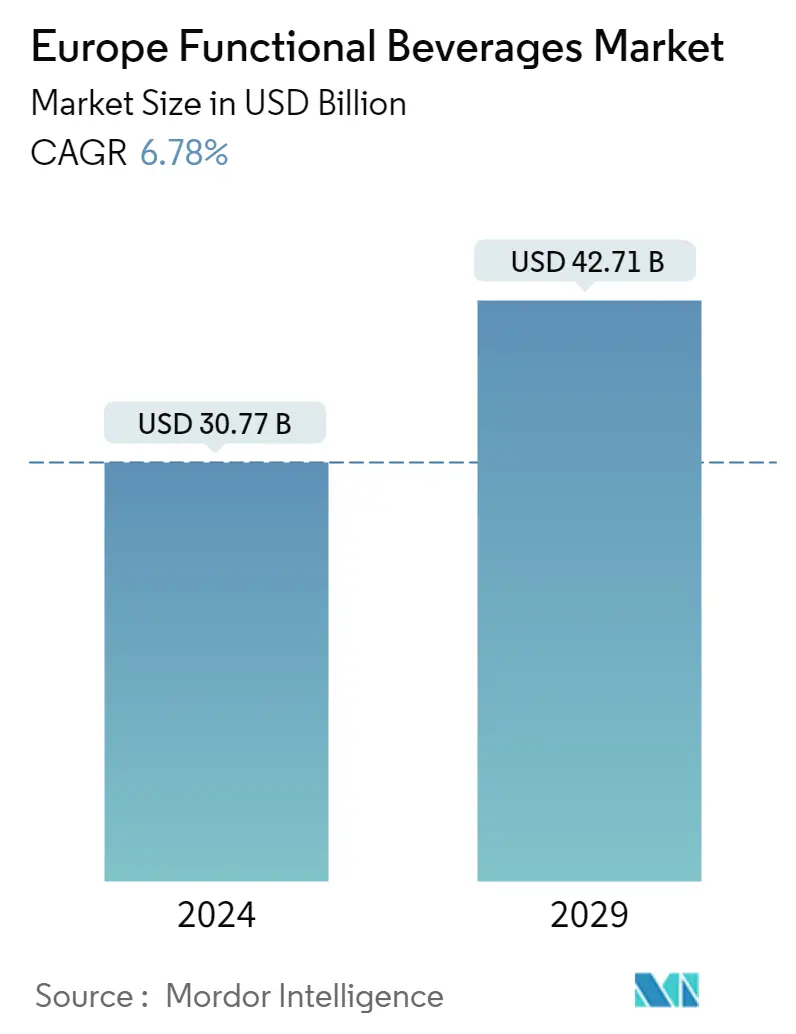
| Study Period | 2018 - 2029 |
| Base Year For Estimation | 2023 |
| Market Size (2024) | USD 30.77 Billion |
| Market Size (2029) | USD 42.71 Billion |
| CAGR (2024 - 2029) | 6.78 % |
| Market Concentration | Low |
Major Players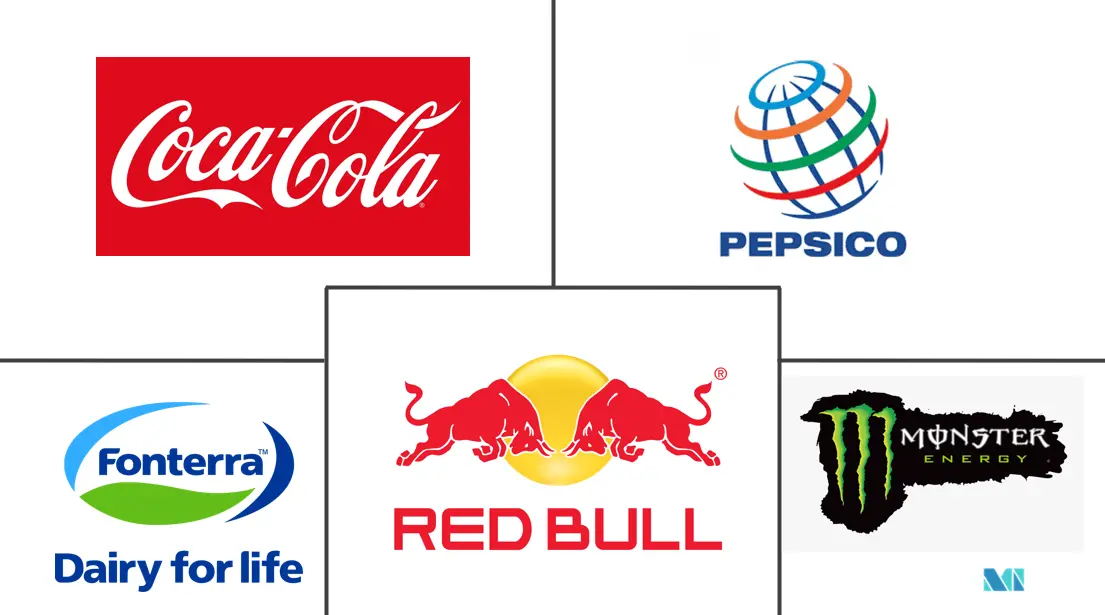
*Disclaimer: Major Players sorted in no particular order |
Europe Functional Beverage Market Analysis
The Europe Functional Beverages Market size is estimated at USD 30.77 billion in 2024, and is expected to reach USD 42.71 billion by 2029, growing at a CAGR of 6.78% during the forecast period (2024-2029).
Functional beverages such as energy drinks offer various health benefits due to the presence of carbohydrates, electrolytes, and minerals such as calcium, magnesium, and sodium. They keep the body hydrated during activities that require excessive energy such as sports, exercises, and workouts. Similarly, the consumption of probiotic drinks helps prevent bowel diseases and strengthen the immune system. These benefits coupled with rising consumer awareness are driving the growth of the market. For example, in the United Kingdom, 21% of functional beverage consumers show an interest in sports or energy drinks that support brain function. In addition, the growing popularity of e-commerce is anticipated to further boost the growth of the functional beverage market in Europe during the forecast period. However, increasing concerns about obesity will reduce the demand in the market.
Consumer trends in the health and wellness market are influenced by multiple factors such as the rising demand for healthier drinks. The aging population is fueling the demand to overcome or prevent adverse health conditions, as they consider these functional beverages as 'meal bottles'. Consumers demand high-quality products including organic and natural products due to rising health consciousness. Moreover, the change in consumption patterns in favor of the convenience food industry is supporting market demand. Consumers are looking for healthy alternatives to carbonated drinks such as functional water. German consumers focus more on the quality of functional water as compared to its price while making a purchase and usually prefer well-established brands to private label lines. Manufacturing companies in energy drinks, sports drinks, and functional water in Germany are launching promotional campaigns and advertisements through the use of celebrity endorsements, TV commercials, and other communication methods to gain consumer attention.
Moreover, increasing demand for innovative products, like plant-based and lactose-free beverage products, drives the market study, while the inclusion of CBD-infused functional beverages is expected to be an opportunity for the future market.
Europe Functional Beverage Market Trends
This section covers the major market trends shaping the Europe Functional Beverages Market according to our research experts:
Flavor Innovations Leading to Market Growth
Consumers are increasingly drawn to the health benefits available through functional beverages. People are more concerned about their health and fitness, which in turn increases the demand for functional beverages. Although the gut health and functional foods phenomenon has impacted all aspects of the menu, the beverage category holds the largest opportunity for flavor innovation. Beverages can be incorporated with vitamins and supplements, allowing nutrient-dense ingredients, such as kale and turmeric, to find a natural home. Innovations in the flavor industry have made flavor ingredients, such as natural isojasmone and natural hibiscus extract liquid, possible, which provide a much more accurate and flavorful version of floral flavor for use in products ranging from functional juice blends and enhanced waters to energy drinks. Also, the rising trend of zero-calorie, zero-sugar, and low-carb content soft drinks is rising across the region, boosting the market growth. Natural flavors are gaining traction due to their health benefits and refreshing tastes.
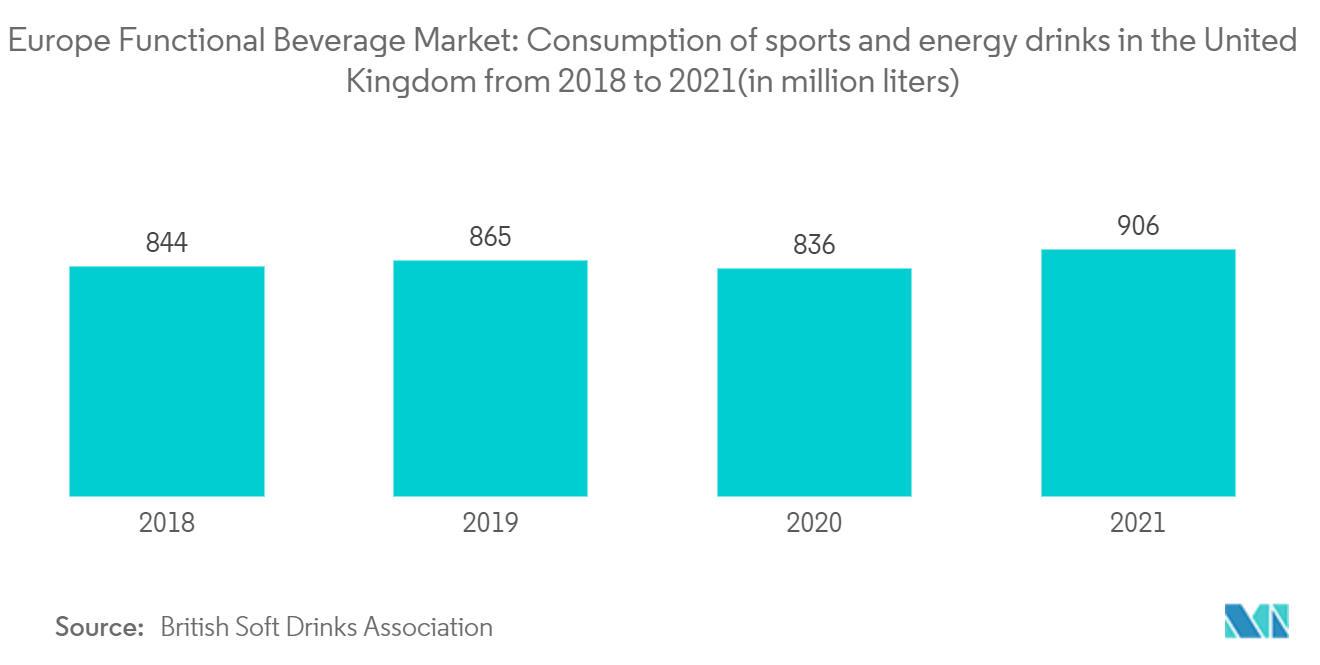
Germany Holds the Major Market Share
The functional beverage market in Germany is benefited from the strong economy and consumers' increasing health consciousness. The aging population is fueling the demand for functional beverages to prevent or overcome adverse health conditions. They consider functional beverages as the 'meal bottle.' Consumers in Germany tend to buy less often. However, they demand high-quality products, including organic and health and wellness food products. The increasing number of single households and a growing mobile society are changing the food and beverage consumption patterns in favor of the convenience food industry.
Thus, there has been a rise in the demand for convenient foods, including ready-to-eat products, fruit juices, and coffee. Also, the penetration of online grocery stores is increasing in European countries such as Germany helps vendors save operating and overhead costs compared to the physical store format. The movement towards organic food products has long since achieved mainstream status in Germany. More and more consumers are seeking to improve their sense of well-being, health, and even their performance levels through the consumption of functional beverages.
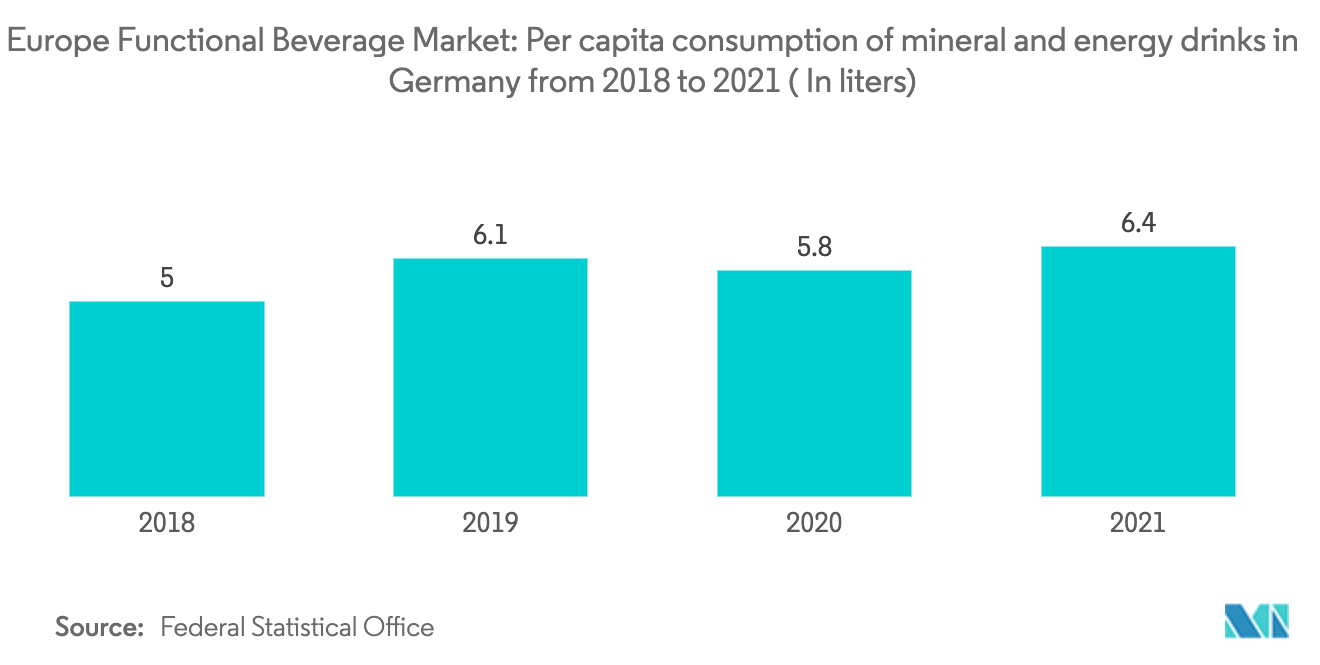
Europe Functional Beverage Industry Overview
The European functional beverage market is a fragmented market with various players operating across segments. Major recognized players include PepsiCo, Coca-Cola, Red Bull, Fonterra Co-operative Group, and Monster Energy. Due to the high growth potential in the region, most companies are trying to expand their presence in the market. Few major players dominate the market due to their extensive distribution channels. Merging is the second most preferred strategy. Major players are merging with local ones to gain dominance in local markets. Product pricing is another strategy adopted by companies.
Europe Functional Beverage Market Leaders
-
Red Bull
-
PepsiCo, Inc.
-
The Coca-Cola Company
-
Fonterra Co-operative Group
-
Monster Energy
*Disclaimer: Major Players sorted in no particular order
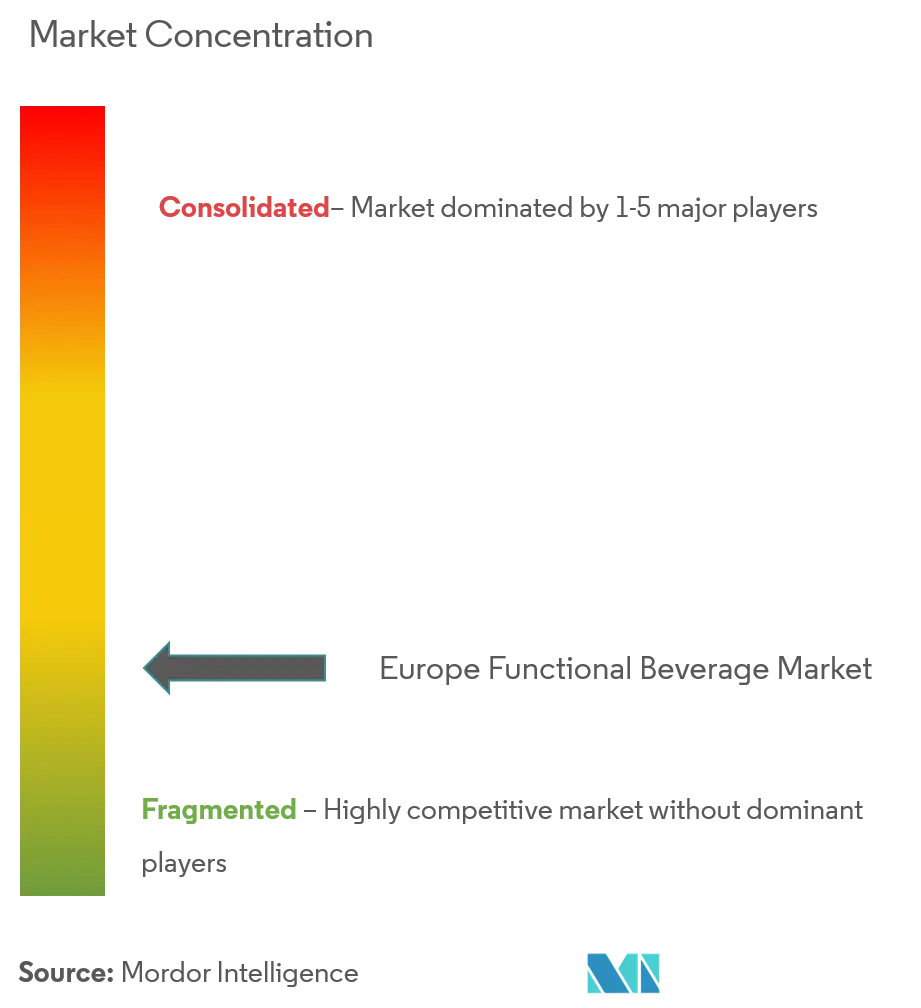
Europe Functional Beverage Market News
In January 2022, Monster drinks launched its new flavor to its core energy drinks lineup with Monster Energy Ultra Watermelon. The products were retailed in supermarkets and convenience stores across the United Kingdom and different parts of Europe.
In April 2021, PepsiCo launched the Rockstar Energy beverage with hemp seed extract in Germany. Rockstar Energy + Hemp contains caffeine, guarana, and taurine.
In January 2021, Coca-Cola European Partners (CCEP) added three new flavors, namely, Monster Mule, Monster Ultra Fiesta, and Monster Juiced Monarch to its 500ml Monster energy drink range.
Europe Functional Beverage Market Report - Table of Contents
1. INTRODUCTION
- 1.1 Study Assumptions and Market Definition
- 1.2 Scope of the Study
2. RESEARCH METHODOLOGY
3. EXECUTIVE SUMMARY
4. MARKET DYNAMICS
- 4.1 Market Drivers
- 4.2 Market Restraints
-
4.3 Porter's Five Forces Analysis
- 4.3.1 Threat of New Entrants
- 4.3.2 Bargaining Power of Buyers/Consumers
- 4.3.3 Bargaining Power of Suppliers
- 4.3.4 Threat of Substitute Products
- 4.3.5 Intensity of Competitive Rivalry
5. MARKET SEGMENTATION
-
5.1 Type
- 5.1.1 Energy Drinks
- 5.1.2 Sports Drinks
- 5.1.3 Fortified Juice
- 5.1.4 Dairy and Dairy Alternative Drinks
- 5.1.5 Other Types
-
5.2 Distribution Channel
- 5.2.1 Supermarkets/Hypermarkets
- 5.2.2 Health Stores
- 5.2.3 Convenience Stores
- 5.2.4 Online Retail Stores
- 5.2.5 Other Distribution Channels
-
5.3 Country
- 5.3.1 Germany
- 5.3.2 United Kingdom
- 5.3.3 France
- 5.3.4 Italy
- 5.3.5 Spain
- 5.3.6 Russia
- 5.3.7 Rest of Europe
6. COMPETITIVE LANDSCAPE
- 6.1 Most Adopted Strategies
- 6.2 Market Position Analysis
-
6.3 Company Profiles
- 6.3.1 PepsiCo Inc.
- 6.3.2 Red Bull GmbH
- 6.3.3 The Coca-Cola Company
- 6.3.4 Danone SA
- 6.3.5 Monster Beverage Corporation
- 6.3.6 Keurig Dr Pepper Inc.
- 6.3.7 Fonterra Co-operative Group
- 6.3.8 Energy Beverages LLC
- 6.3.9 Nestle SA
- 6.3.10 Rockstar Inc.
- *List Not Exhaustive
7. MARKET OPPORTUNITIES AND FUTURE TRENDS
** Subject To AvailablityEurope Functional Beverage Industry Segmentation
A functional beverage is a conventional liquid food marketed to highlight specific ingredients or supposed health benefits. The European functional beverage market is segmented by type, distribution channel, and country. By type, it is segmented into energy drinks, fortified juice, sports drinks, dairy and dairy alternative drinks, and other types. By distribution channel, the market is segmented into supermarkets/hypermarkets, health stores, convenience stores, online retail stores, and other distribution channels. By country, the market is segmented into Germany, the United Kingdom, France, Italy, Spain, Russia, and the Rest of Europe. For each segment, the market sizing and forecasts have been done based on value (in USD Million).
| Type | Energy Drinks |
| Sports Drinks | |
| Fortified Juice | |
| Dairy and Dairy Alternative Drinks | |
| Other Types | |
| Distribution Channel | Supermarkets/Hypermarkets |
| Health Stores | |
| Convenience Stores | |
| Online Retail Stores | |
| Other Distribution Channels | |
| Country | Germany |
| United Kingdom | |
| France | |
| Italy | |
| Spain | |
| Russia | |
| Rest of Europe |
Europe Functional Beverage Market Research FAQs
How big is the Europe Functional Beverages Market?
The Europe Functional Beverages Market size is expected to reach USD 30.77 billion in 2024 and grow at a CAGR of 6.78% to reach USD 42.71 billion by 2029.
What is the current Europe Functional Beverages Market size?
In 2024, the Europe Functional Beverages Market size is expected to reach USD 30.77 billion.
Who are the key players in Europe Functional Beverages Market?
Red Bull, PepsiCo, Inc., The Coca-Cola Company, Fonterra Co-operative Group and Monster Energy are the major companies operating in the Europe Functional Beverages Market.
What years does this Europe Functional Beverages Market cover, and what was the market size in 2023?
In 2023, the Europe Functional Beverages Market size was estimated at USD 28.82 billion. The report covers the Europe Functional Beverages Market historical market size for years: 2018, 2019, 2020, 2021, 2022 and 2023. The report also forecasts the Europe Functional Beverages Market size for years: 2024, 2025, 2026, 2027, 2028 and 2029.
Functional Beverage in Europe Industry Report
Statistics for the 2024 Functional Beverage in Europe market share, size and revenue growth rate, created by Mordor Intelligence™ Industry Reports. Functional Beverage in Europe analysis includes a market forecast outlook to 2029 and historical overview. Get a sample of this industry analysis as a free report PDF download.



